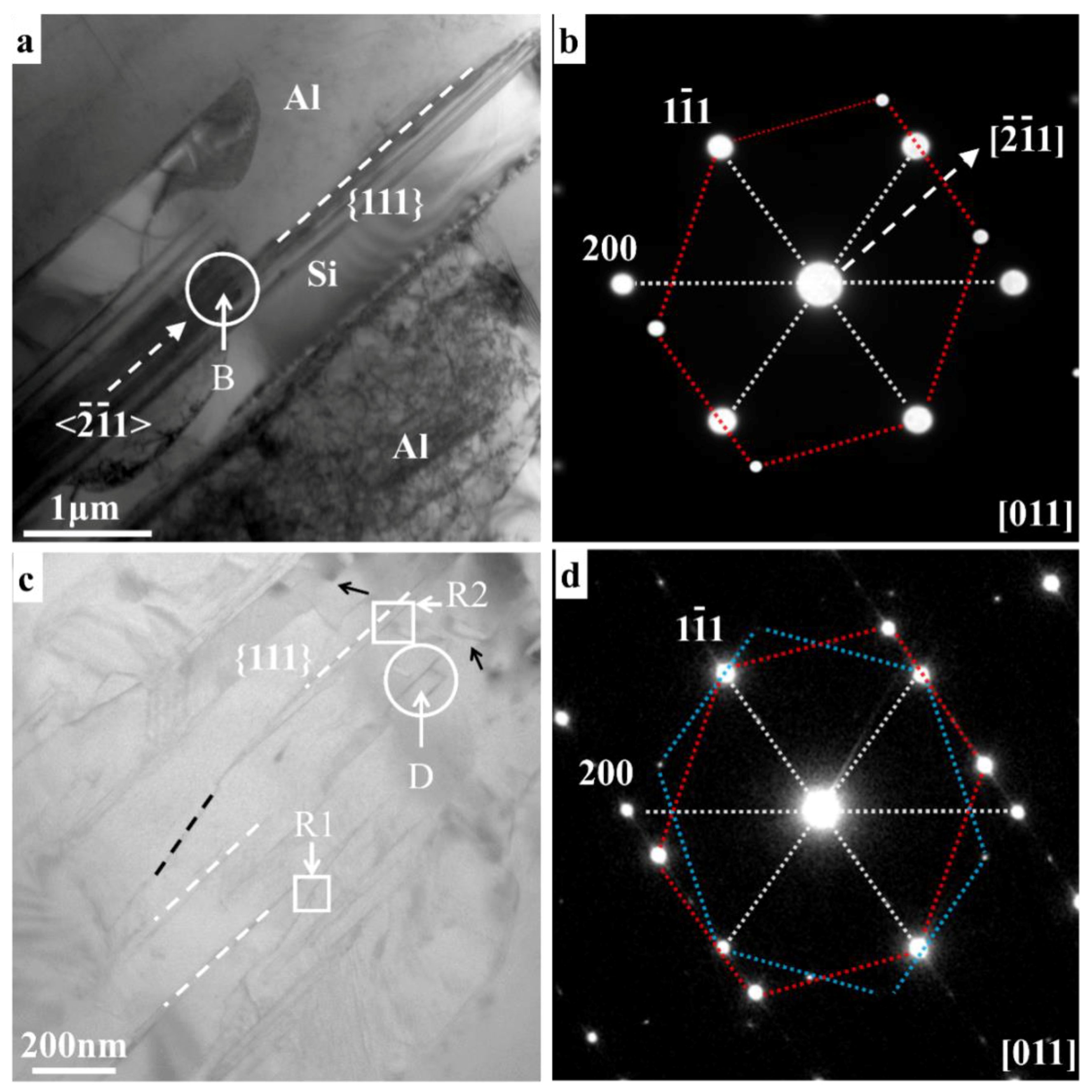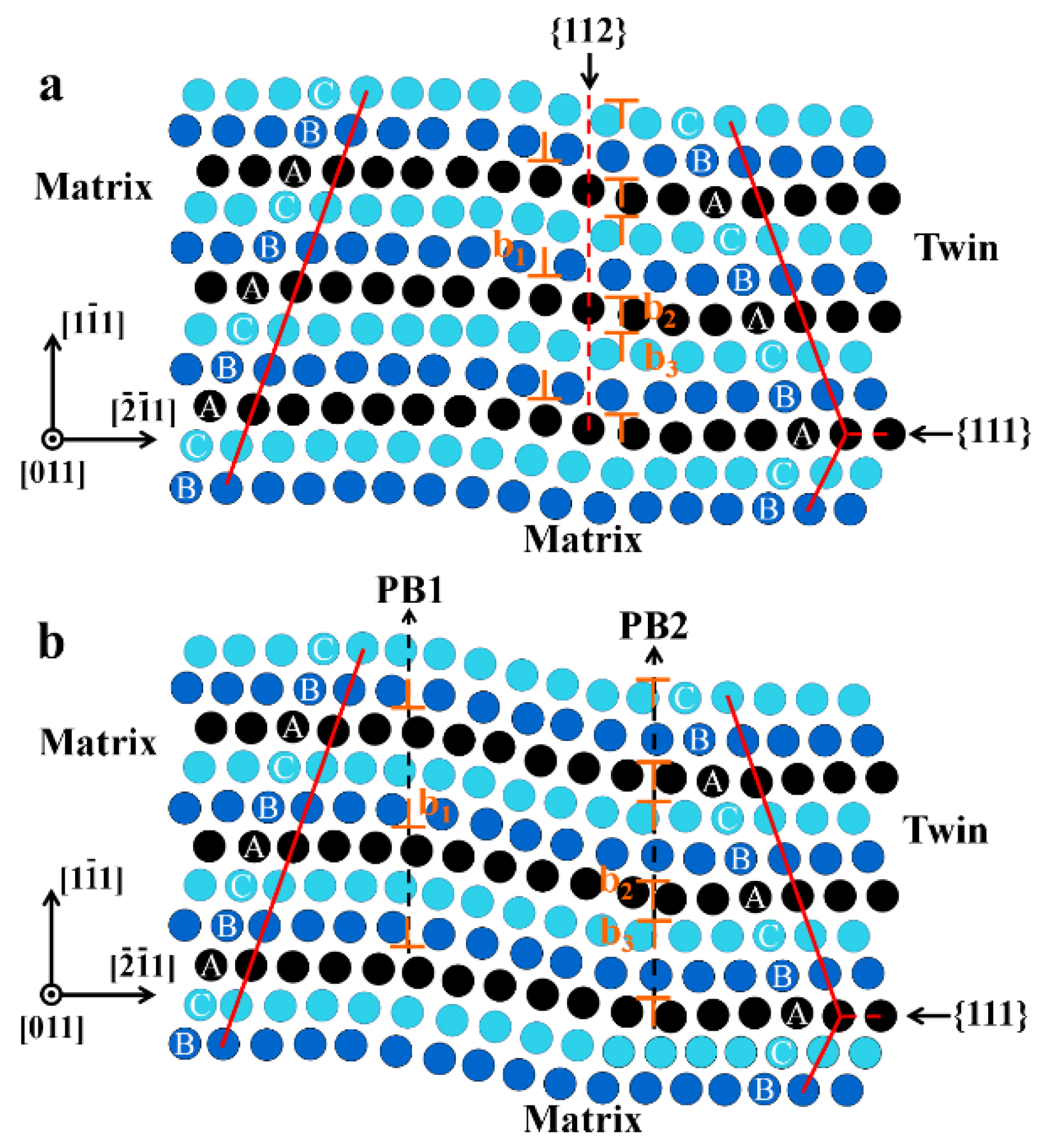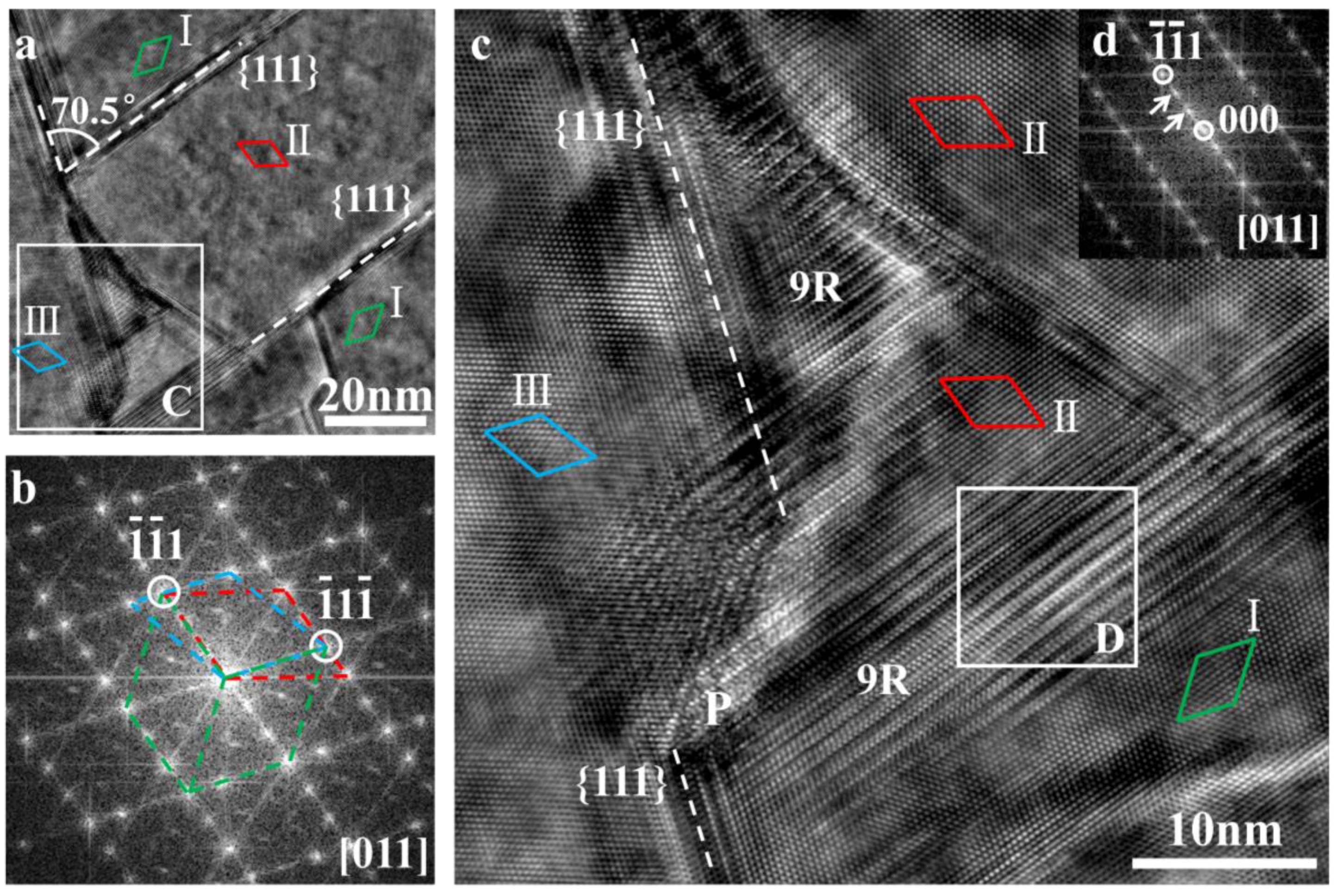Modification of Eutectic Si in Al-Si-(Ba) Alloy by Inducing a Novel 9R Structure in Twins
Abstract
:1. Introduction
2. Material and Methods
3. Results and Discussion
4. Conclusions
- In the Ba-free Al-Si alloy, the size of the eutectic Si is large, which is a result of the uniaxial growth of strip-shaped twins in Si grains. Meanwhile, the morphology of twins exhibits a combination of normal twins, discontinuous twins, and multiple twins in Ba-containing Al-Si alloy. Ba addition modified the eutectic Si from coarse plate-like into fine fibrous, which is the optimized microstructure for both strength and ductility.
- A novel 9R structure is observed at the turning of discontinuous twins, which is first reported in the cast Al-Si alloy. The phase boundary of the 9R structure is a large mismatched region that leads to the growth of twins with steps to form discontinuous twins.
- The 9R structure is also observed at the intersection of multiple twins. It indicates that the formation of multiple twins may induced by a different stacking sequence between 9R and the matrix, which is similar to the IIT (impurity-induced twinning) mechanism.
Author Contributions
Funding
Acknowledgments
Conflicts of Interest
References
- Shabani, M.O.; Mazahery, A. Prediction of Mechanical Properties of Cast A356 Alloy as a Function of Microstructure and Cooling Rate. Arch. Metall. Mater. 2011, 56, 671–675. [Google Scholar] [CrossRef]
- Shabani, M.O.; Mazahery, A.; Bahmani, A.; Davami, P.; Varahram, N. Solidification of A356 Al alloy: Experimental study and modeling. Kovove Mater. 2012, 49, 253–258. [Google Scholar] [CrossRef]
- Bahmani, A.; Hatami, N.; Varahram, N.; Davami, P.; Shabani, M.O. A mathematical model for prediction of microporosity in aluminum alloy A356. Int. J. Adv. Manuf. Technol. 2013, 64, 1313–1321. [Google Scholar] [CrossRef]
- Bahmani, A.; Eisaabadi, G.B.; Davami, P.; Varahram, N.; Shabani, M.O. Effects of hydrogen level and cooling rate on ultimate tensile strength of Al A319 alloy. Russ. J. Non-Ferrous Met. 2014, 55, 365–370. [Google Scholar] [CrossRef]
- Mazahery, A.; Shabani, M.O. Experimental Investigation on the Aging Response, Hardness and Total Impact Energy Absorption of Sr-Modified Heat-Treatable Cast Automotive Aluminum Alloys. Trans. Indian Inst. Met. 2014, 67, 753–759. [Google Scholar] [CrossRef]
- Shabani, M.O.; Mazahery, A. Automotive copper and magnesium containing cast aluminium alloys: Report on the correlation between Yttrium modified microstructure and mechanical properties. Russ. J. Non-Ferrous Met. 2014, 55, 436–442. [Google Scholar] [CrossRef]
- Hamilton, D.R.; Seidensticker, R.G. Propagation mechanism of germanium dendrites. J. Appl. Phys. 1960, 31, 1165–1168. [Google Scholar] [CrossRef]
- Wagner, R.S. On the growth of germanium dendrites. Acta Metall. 1960, 8, 57–60. [Google Scholar] [CrossRef]
- Mazahery, A.; Shabani, M.O. Modification Mechanism and Microstructural Characteristics of Eutectic Si in Casting Al-Si Alloys: A Review on Experimental and Numerical Studies. JOM 2014, 66, 726–738. [Google Scholar] [CrossRef]
- Pacz, A. Alloy. U.S. Patent No. 1387900A, 16 August 1921. [Google Scholar]
- Mohanty, P.S.; Gruzleski, J.E. Grain refinement mechanisms of hypoeutectic Al-Si alloys. Acta Mater. 1996, 44, 3749–3760. [Google Scholar] [CrossRef]
- Polmear, I.; StJohn, D.; Nie, J.F.; Qian, M. Light Alloys: Metallurgy of the Light Metals, 5th ed.; John Wiley & Sons: Hoboken, NJ, USA, 1981. [Google Scholar]
- Jia, Y.D.; Cao, F.Y.; Scudino, S.; Ma, P.; Li, H.C.; Yu, L.; Eckert, J.; Sun, J.F. Microstructure and thermal expansion behavior of spray-deposited Al-50Si. Mater. Des. 2014, 57, 585–591. [Google Scholar] [CrossRef]
- Cui, C.; Schulz, A.; Epp, J.; Zoch, H.W. Deformation behavior of spray-formed hypereutectic Al–Si alloys. J. Mater. Sci. 2010, 45, 2798–2807. [Google Scholar] [CrossRef]
- Griffiths, W.D.; McCartney, D.G. The effect of electromagnetic stirring during solidification on the structure of Al-Si alloys. Mater. Sci. Eng. A 1996, 216, 47–60. [Google Scholar] [CrossRef]
- Sukumaran, K.; Pai, B.C.; Chakraborty, M. The effect of isothermal mechanical stirring on an Al–Si alloy in the semisolid condition. Mater. Sci. Eng. A 2004, 369, 275–283. [Google Scholar] [CrossRef]
- Abramov, V.O.; Abramov, O.V.; Straumal, B.B.; Gust, W. Hypereutectic Al-Si based alloys with a thixotropic microstructure produced by ultrasonic treatment. Mater. Des. 1997, 18, 323–326. [Google Scholar] [CrossRef]
- Eskin, G.I. Broad prospects for commercial application of the ultrasonic (cavitation) melt treatment of light alloys. Ultrason. Sonochem. 2001, 8, 319–325. [Google Scholar] [CrossRef]
- Day, M.G.; Hellawell, A. The microstructure and crystallography of aluminum-silicon eutectic alloys. Proc. Math. Phys. Eng. Sci. 1968, 305, 473–491. [Google Scholar] [CrossRef]
- Lu, S.Z.; Hellawell, A. The mechanism of silicon modification in aluminum-silicon alloys: Impurity induced twinning. Metall. Trans. A 1987, 18, 1721–1733. [Google Scholar] [CrossRef]
- Li, J.H.; Suetsugu, S.; Tsunekawa, Y.; Schumacher, P. Refinement of eutectic Si phase in Al-5Si alloys with Yb additions. Metall. Mater. Trans. A 2013, 44, 669–681. [Google Scholar] [CrossRef]
- Li, J.H.; Albu, M.; Hofer, F.; Schumacher, P. Solute adsorption and entrapment during eutectic Si growth in A-Si-based alloys. Acta Mater. 2015, 83, 187–202. [Google Scholar] [CrossRef]
- Li, J.H.; Wang, X.D.; Ludwig, T.H.; Tsunekawa, Y.; Arnberg, L.; Jiang, J.Z.; Schumacher, P. Modification of eutectic Si in Al-Si alloys with Eu addition. Acta Mater. 2015, 84, 153–163. [Google Scholar] [CrossRef]
- Nogita, K.; Knuutinen, A.; McDonald, S.D.; Dahle, A.K. Mechanisms of eutectic solidification in Al-Si alloys modified with Ba, Ca, Y and Yb. J. Light Met. 2001, 1, 219–228. [Google Scholar] [CrossRef]
- Rittner, J.D.; Seidman, D.N.; Merkle, K.L. Grain-boundary dissociation by the emission of stacking faults. Phys. Rev. B 1996, 53, 4241–4244. [Google Scholar] [CrossRef]
- Liu, L.; Wang, J.; Gong, S.K.; Mao, S.X. High resolution transmission electron microscope observation of zero-strain deformation twinning mechanisms in Ag. Phys. Rev. Lett. 2011, 106. [Google Scholar] [CrossRef] [PubMed]
- Wang, J.; Li, N.; Anderoglu, O.; Zhang, X.; Misra, A.; Huang, J.Y.; Hirth, J.P. Detwinning mechanisms for growth twins in face-centered cubic metals. Acta Mater. 2010, 58, 2262–2270. [Google Scholar] [CrossRef]
- Wang, J.; Anderoglu, O.; Hirth, J.P.; Misra, A.; Zhang, X. Dislocation structures of ∑3{112} twin boundaries in face centered cubic metals. Appl. Phys. Lett. 2009, 95, 021908. [Google Scholar] [CrossRef]
- Wu, X.L.; Liao, X.Z.; Srinivasan, S.G.; Zhou, F.; Lavernia, E.J.; Valiev, R.Z.; Zhu, Y.T. New deformation twinning mechanism generates zero macroscopic strain in nanocrystalline metals. Phys. Rev. Lett. 2008, 100. [Google Scholar] [CrossRef] [PubMed]
- Zhu, Y.T.; Liao, X.Z.; Wu, X.L. Deformation twinning in nanocrystalline materials. Prog. Mater. Sci. 2012, 57, 1–62. [Google Scholar] [CrossRef] [Green Version]
- Wang, J.; Misra, A.; Hirth, J.P. Shear response of ∑3{112} twin boundaries in face-centered-cubic metals. Phys. Rev. B 2011, 83. [Google Scholar] [CrossRef]
- Li, B.Q.; Li, B.; Wang, Y.B.; Sui, M.L.; Ma, E. Twinning mechanism via synchronized activation of partial dislocations in face-centered-cubic materials. Scr. Mater. 2011, 64, 852–855. [Google Scholar] [CrossRef]
- Kurz, W.; Giovanola, B.; Trivedi, R. Theory of microstructural development during rapid solidification. Acta Metall. 1986, 34, 823–830. [Google Scholar] [CrossRef]
- Liu, P.; Du, K.; Zhang, J.X.; Wang, L.H.; Yue, Y.H.; Ma, E.; Zhang, Y.F.; Zhang, Z.; Chen, M.W.; Han, X.D. Screw-rotation twinning through helical movement of triple-partials. Appl. Phys. Lett. 2012, 101, 121901. [Google Scholar] [CrossRef]
- Ernst, F.; Finnis, M.W.; Hofmann, D.; Muschik, T.; Schönberger, U.; Wolf, U.; Methfessel, M. Theoretical prediction and direct observation of the 9R structure in Ag. Phys. Rev. Lett. 1992, 69, 620–623. [Google Scholar] [CrossRef] [PubMed]
- Zhang, J.Y.; Zhang, P.; Wang, R.H.; Liu, G.; Zhang, G.J.; Sun, J. Grain-size-dependent zero-strain mechanism for twinning in copper. Phys. Rev. B 2012, 86, 064110. [Google Scholar] [CrossRef]
- Amin-Ahmadi, B.; Idrissi, H.; Delmelle, R.; Pardoen, T.; Proost, J.; Schryvers, D. High resolution transmission electron microscopy characterization of FCC→9R transformation in nanocrystalline palladium films due to hydriding. Appl. Phys. Lett. 2013, 102, 607. [Google Scholar] [CrossRef]




© 2018 by the authors. Licensee MDPI, Basel, Switzerland. This article is an open access article distributed under the terms and conditions of the Creative Commons Attribution (CC BY) license (http://creativecommons.org/licenses/by/4.0/).
Share and Cite
Sha, X.; Chen, X.; Ning, H.; Xiao, L.; Yin, D.; Mao, L.; Zheng, J.; Zhou, H. Modification of Eutectic Si in Al-Si-(Ba) Alloy by Inducing a Novel 9R Structure in Twins. Materials 2018, 11, 1151. https://doi.org/10.3390/ma11071151
Sha X, Chen X, Ning H, Xiao L, Yin D, Mao L, Zheng J, Zhou H. Modification of Eutectic Si in Al-Si-(Ba) Alloy by Inducing a Novel 9R Structure in Twins. Materials. 2018; 11(7):1151. https://doi.org/10.3390/ma11071151
Chicago/Turabian StyleSha, Xuechao, Xuefei Chen, Huiyan Ning, Lirong Xiao, Dongdi Yin, Lin Mao, Jiang Zheng, and Hao Zhou. 2018. "Modification of Eutectic Si in Al-Si-(Ba) Alloy by Inducing a Novel 9R Structure in Twins" Materials 11, no. 7: 1151. https://doi.org/10.3390/ma11071151




